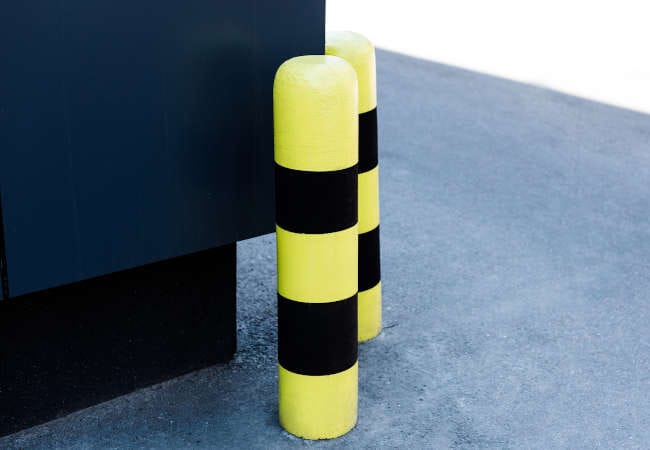Bollards, robust vertical posts, are pivotal in maintaining safety and security across various locations. This comprehensive guide delves into bollards’ types, uses, designs, and installation, presenting their critical role in traffic control and safeguarding pedestrians, structures, and equipment.
Understanding Bollard Uses
Numerous established uses of bollards have emerged, highlighting their critical role in various sectors from security and protection to traffic guidance and damage prevention. Bollards serve as a physical and visual deterrent to threats, protecting vulnerable machinery and infrastructure from potential damage. They are an effective means of collision prevention, which can result in significant cost savings.
Commonly found in airports, gas stations, parking garages, commercial parking lots, and schools, bollards serve as a safety measure while aiding in the smooth flow of both vehicular and pedestrian traffic. Besides their practical uses, bollards are also used as a visual alert to guide drivers and pedestrians, enhancing safety in high-traffic areas.
The benefits of bollards extend to asset protection and access control. Bollards can protect critical infrastructure, equipment, and personnel by controlling the movement of vehicles and people. Furthermore, bollards are cost-effective, requiring minimal maintenance while providing maximum safety and security. Modern bollards, whether constructed from steel or polymer, are designed to absorb and dissipate the impact energy, thus minimizing potential damage.
Common Bollard Locations
Bollards are prominently installed in various locations worldwide, serving distinct purposes based on their environment. They offer security, protection, guidance, and control in areas where safety and access regulation are paramount.
Commonly, bollards are found in airports where they create a secure boundary on tarmacs and facilitate safe pedestrian walkways. Gas stations also employ bollards to protect gas pumps from accidental vehicle impacts, ensuring safe refueling. Bollards safeguard the structure and clearly set walkways in parking garages, contributing to overall safety.
Commercial locations such as retail stores, shopping malls, and restaurant drive-thrus use bollards to secure their perimeters and prevent accidents. Schools also utilize bollards to separate vehicle traffic from pedestrian areas, making schools much safer during high-traffic times such as drop-off and pick-up times. This aids in maintaining a safe environment for students.

Comparing Steel and Polymer Bollards
The comparison between steel and polymer bollards is vital in understanding their effectiveness in different environments and situations. Steel bollards are known for their robustness and durability. They resist high impacts and are preferred in locations with heavy vehicular traffic or potential security threats. Their ability to endure harsh weather conditions and their longevity make them a cost-effective choice for long-term applications.
On the other hand, polymer bollards are praised for their flexibility and impact absorption capabilities. These bollards are designed to bend upon impact, reducing damage to both the bollard and the vehicle. They are highly corrosion-resistant, making them ideal for coastal or corrosive environments. Additionally, their lightweight nature facilitates easy installation and replacement.
However, the choice between steel and polymer bollards is not a one-size-fits-all solution. The selection should be based on the site’s specific needs, such as the expected type of traffic, potential risk factors, and environmental conditions. In some cases, a combination of both materials may be the most effective solution, providing a balance of durability, flexibility, and cost-effectiveness.
Bollard Protection Solutions
Implementing effective bollard protection solutions is important for enhancing the safety and security of public spaces, commercial properties, and private premises. These solutions are designed to control vehicular and pedestrian traffic, protect vulnerable structures, and deter unauthorized access.
Bollard protection systems can be customized to meet specific needs, ranging from low-impact decorative bollards to high-impact security bollards. Their materials and designs can vary, with options including steel, stainless steel, cast iron, aluminum, or recycled plastic. The design features can be fixed, removable, collapsible, or retractable.
The installation process is also a key part of bollard protection solutions. The choice of footing type, usually involving concrete and reinforcing steel, ensures the bollards are securely grounded. Bollard spacing is carefully calculated based on the type of vehicles that need to be kept out or allowed access.
In addition, bollards are a cost-effective safety measure, often capable of absorbing up to 80% of an impact, thereby protecting both people and infrastructure. Hence, the role of bollards in providing a safe and secure environment cannot be overstated. Their strategic implementation significantly enhances the safety and security of various spaces.
Conclusion
In conclusion, bollards enhance safety and security in various environments.
Their versatility allows them to direct traffic, protect pedestrians and infrastructure, guide drive-thru lanes, and streamline operations in industrial settings.
By understanding the benefits and applications of different bollard materials and designs, suitable protection solutions can be implemented.
Customized bollard solutions further offer tailored security measures.
Thus, bollards prove to be an indispensable tool in ensuring safety in diverse settings.

